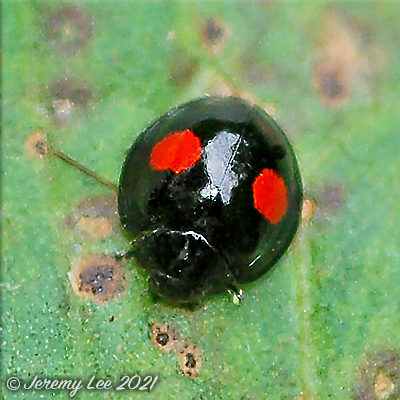
 |
|
Scientific Classifications explained » Amphibians » Ants » Aphids » Bees » Beetles » Birds » Bugs » Butterflies » Caterpillars » Damselflies » Dragonflies » Earwigs » Flies » Frog/Leafhoppers » Fungi » Galls » Grasshoppers » Harvestmen » Hoverflies » Lacewings » Ladybirds » Leaf Mines » Lichens » Mammals » Millipedes » Mosses » Moths » Sawflies » Slugs » Snails » Spiders » Trees & Shrubs » Wasps » Wild Flowers » Woodlice » Postboxes |
UK Nature > Ladybirds > Chilocorus renipustulatus

Scientific Name: Chilocorus renipustulatus Common Name: Kidney-spot Ladybird Chilocorus renipustulatus, more commonly known as the Kidney-spot Ladybird, has a black body with a large red spot on each wing casing and black legs. It is a very round ladybird with a domed shape in profile. The antennae and underside are orange. The wing casings have a distinctly flattened flange all the way round. It is quite a small ladybird at about 4-5 mm and can be found, April to October, in well-wooded areas, often on deciduous trees, particularly sallows. It is often found on trunks, branches and twigs, rather than leaves. It feeds on scale insects on the bark of trees and is fairly frequent in England and Wales, overwintering in sheltered positions near the base of trees. |
|

https://www.uknature.co.uk is a website dedicated to showing the immense diversity of UK nature and wildlife. Our vast range of habitats, from lowland arable to snow covered mountains, from storm-ravaged coastlines to peaceful inland freshwater lakes and rivers, from dry, sandy heaths to deciduous and coniferous forests, all these habitats contribute to the abundance of UK nature. We have wild birds in huge numbers either residing or visiting our shores (597 recorded species as at July 2013) and we must also not forget the humble back garden with its grass lawns, flower beds filled with nectar rich flowers, shrubs and trees, all designed to attract huge numbers of insects such as bees, moths, butterflies and hoverflies; and finally the small ponds which provide safe havens for frogs, toads, newts and even slow worms and grass snakes. www.uknature.co.uk is the showcase for my personal passion, photographing uknature in all its glory. I sincerely hope you all enjoy the fruits of my labours. This site and all images contained therein is © Jeremy Lee 2004 - 2025. All Rights Reserved. Site design by Jeremy Lee. Site development & IT Support by Stuart Lee. |